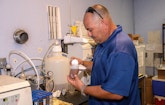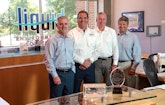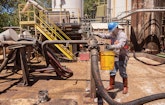
Jason Jesmer, logistics manager, pointing, and Johathan Hanes, logistics analyst, reviewing the day’s routing at a Liquid Environmental Solutions office.
Pumping companies looking to diversify services, as well as generate an additional revenue stream by collecting and recycling grease trap waste, may benefit from business-building strategies utilized by a giant in the commercial wastewater industry.
The lessons from Liquid Environmental Solutions include nurturing good employees, making smart investments in technology and equipment, emphasizing employee safety, and growing through acquisition; the company has added nearly two dozen companies in 16 years.
To grasp the size of the Dallas-based company, consider these figures: Nearly 400 million gallons of grease trap waste and roughly 100 million pounds of used cooking oil are collected and recycled annually. More than 3.6 million gallons of brown grease recovered annually from grease trap waste. Approximately 650 employees working at 52 different branch locations. Two dozen treatment facilities that handle everything from grease trap waste to grit from car-wash pits. In excess of $150 million in annual gross revenue. And more than 500 pieces of rolling stock, including several hundred tanker trailers and vacuum trucks rolling across the nation’s roads and highways.
Dana King, senior vice president, notes the company serves more than 20,000 clients at more than 65,000 locations. “We’ve grown at about a 10 percent clip every year,” he says, “which has always been our target.”
A giant monitor inside the company’s Dallas operations center, which handles all service dispatching, graphically reveals the scope of the company’s operations. It displays a map of the United States that includes hundreds of color-coded dots — one color for grease-collection trucks, another for cooking oil-collection trucks, and so forth. It’s part of a business-enterprise/management system custom-developed in-house, King notes.
“We can see our trucks running all over the country,” he says of the central-dispatching monitor. “But we still give our local teams the ability to make their own (dispatching) decisions to best serve their customers in the most efficient way. We rely on strong analytical tools to make our business run well.”
The central dispatch system in the company’s 40,000-square-foot headquarters offers an apt metaphor for the firm’s success: strong central management that still allows local units to operate with a certain degree of autonomy. “Part of the way we continue to grow — and grow successfully — is a strong management team,” King explains. “But we also give employees and management staff the tools they need to get the job done and think outside the box when opportunities arise to better serve the customer and the environment.”
ROOTS IN TEXAS
The company is principally owned by the Audax Group. But it was originally established in 2002 when King, Alan Viterbi (now the Liquid Environmental Solutions chief executive officer), and two other now-retired partners — Rich Leib and Patrick Reilly — bought the Texas division of a liquid waste company called U.S. Liquids. At the time, Liquid Environmental Solutions served customers in Texas and northern Louisiana from six locations: Dallas, Houston, San Antonio, Austin, and Harlingen, Texas, plus Shreveport, Louisiana, King says.
Services at that point included treating industrial wastewater and pumping grease and grit traps. But as guidelines for collection and disposal of grease trap waste became more stringent — driven by sanitary sewer overflows caused by fats, oils and grease (FOG) — management decided an emphasis on grease presented the most-promising business opportunity.
“We felt the marketplace was going to need help complying with new government rules and regulations aimed at making sure grease traps and related infrastructure were well-maintained,” King explains. “The No. 1 cause of sewer overflows back then was FOG. In essence, we looked at this in 2002 and decided to build a company to serve the needs of our customers — primarily restaurants and any other businesses that include food service in its mix, such as hotels, hospitals, prisons, schools, grocery stores, and so forth. In essence, any facility that has a kitchen with a grease trap.”
Organic growth came quickly, boosted by a sales team that focused on national customers, such as restaurant chains. Acquisitions of companies that collect either grease or nonhazardous industrial waste also played a big role in company expansion, he says.
By 2007, the company had customers in five states. By 2010, the number mushroomed to 32 states. Today, it covers all 50 states, either through branch facilities or another critical growth component: preferred partners — waste-collection businesses that Liquid Environmental Solutions hires if they meet rigorous company standards, King says.
“FedEx did the same thing when it first started,” he points out. “At first, it didn’t have branches everywhere but still needed to deliver packages. So it hired agents to help out until the company was capable of doing it on its own.
“When you build a national company, the customers want you to be able to service certain markets,” he adds. “And to build out that network, we relied on either acquisitions or our preferred-partner program. We still don’t have any trucks in Hawaii or Alaska and several other states, like Montana and North and South Dakota, where preferred partners service customers on our behalf.”
COLLECT, TREAT, REUSE
Today, the company’s primary services center on collecting and treating grease trap waste, used cooking oil, and grit from car-wash pits. Grease is treated to remove water and solids (ranging from food and trash to utensils and broken glass) and the remaining product — brown grease — is sold as a low-grade fuel oil.
The same process is employed to treat used cooking oil. The end product “yellow grease” is sold to companies that make products such as animal feed, soap, cosmetics and renewable fuels. “In locations where we don’t have our own treatment plants, we work with the nation’s renderers, providing them with our customers’ used cooking oil, which they render into yellow grease,” King explains.
Car-wash pit waste is treated to separate the water, grit and oils; the grit typically is landfilled and the oil is sold and used to make products such as asphalt. The food waste from grease traps and used cooking oil generally goes to municipalities for use in anaerobic digesters or to composting companies. The water left after treatment gets treated to conform with local requirements and then discharged into municipal wastewater systems for final treatment.
Of course, providing all these services on a national scale requires a huge fleet of equipment and vehicles. The company’s entire fleet includes roughly 150 bobtail vacuum tankers and light-duty trucks (ranging from 300- to 4,000-gallon capacities); 150 tractor cabs; and 200 vacuum tanker trailers (ranging from 5,000- to 6,500-gallon capacities). In recent years, the company has invested primarily in Freightliner, International, and Volvo Construction Equipment trucks and tanker trailers made by Dragon Products, Longhorn Tank & Trailer, and Vantage Trailers.
Investing in new and reliable equipment definitely helps attract and retain good employees. The average age of the company’s equipment is just under six years. “That makes a big difference in mission success,” King points out. “Furthermore, we only buy vehicles with automatic transmissions … which is a big plus for our drivers, as well as our younger drivers, who often are not trained in using standard transmissions.”
SAFETY MATTERS
A strong emphasis on safety training also spurred the company’s growth, in terms of both employee and customer retention, and reduced insurance costs. While grease trap cleaning may seem like a relatively low-risk job, hazards lurk nonetheless, King observes.
“To begin a service, you have to pull the trap lid up and over to gain access to the interceptor,” he explains. “In itself, this can be dangerous if you do not know the proper body mechanics, lifting strategies or tools to use. Pulling too hard on a lid can strain shoulders, arms and backs. Not using the right tool can cause smashed fingers or toes.
“Furthermore, operating the pumps and tank equipment also can be very dangerous,” he continues. “Under pressure, hoses can whip and jump … causing muscle strains. They also can rupture and release material that makes contact with eyes and skin, causing injury, infections, and illnesses. And removing a valve cap without making sure the tank is not pressurized is a good way to fracture ribs or suffer a laceration.”
Employees receive initial as well as ongoing safety training provided primarily by staff and sometimes by outside consultants. This effort includes monthly nationwide training sessions for all employees, conducted live via Skype. “We see and hear them as they see and hear us,” King says. “It gives us the ability to make sure the training topic and material is understood and to interact with the entire team by answering questions and provoking conversation.”
Investments in safety programs and training are a significant incentive to employees’ success and retention. “Pure and simple, our team members know that we want them to be safe for their interest as well as their family’s interest,” King says. “And one reason our customers do business with us is because they see the results of the training and the programs to which our team adheres. They know that our team will not cut corners or do anything that might negatively impact their business … and that we follow regulations and take care of business in a professional and safe manner.”
MOVING FORWARD
Liquid Environmental Solutions typically prefers acquiring existing companies over starting from scratch because the latter takes more time to develop. Strong employees and a strategic location make for good candidates for acquisitions, King says. “We always need a reliable stream of grease trap waste, which is a high-energy commodity for anaerobic-digestion facilities owned by municipalities,” he explains. “They need a reliable partner to deliver material so they can increase biomethane production.”
Looking ahead, King expects continued growth for Liquid Environmental Solutions. He sees the company’s primary mission as continuing development of new and better solutions for customers that protect the value of their wastewater infrastructure, ensures full compliance and confidence in their regulatory oversight, and maximizes the sustainability of their business.
“We will essentially continue to embrace … a comprehensive management philosophy that builds value for our customers, our employee team members, and our shareholders,” King says.
Stick to your focus
When Liquid Environmental Solutions was established in 2002, it didn’t collect used cooking oil, generated by restaurant deep-fat fryers and griddles. But after repeated requests from customers, the company began providing such service in 2008, says Dana King, senior vice president of the Dallas-based company.
“We looked at the way this service was being provided and thought we could do it better,” he says. “Now it’s an important part of our service profile. … That experience made us realize we can never have a static business model.”
This move to diversify the company’s primary grease-collection services offers an example of its business model in action. Management calls it the four pillars, which represent a strong commitment to the environment, customer service, safety and compliance, and continuous improvement, he says.
The focus points help ensure customers receive outstanding value and a well-maintained infrastructure, buttressed by technicians that follow the letter — as well as the spirit of — local, state, and national laws and regulations. In fact, the company keeps a complete database of compliance regulations for every jurisdiction in the country, King explains.
In another example, the company urges employees at the company’s waste treatment facilities to always look for new ways to recycle and recover waste. That led one employee to develop a process for recycling the water used for treating brown grease, as well as turning the grease into a low-grade boiler fuel. The inspiration for the process came from the employee’s prior experience in the rendering industry.
“Like many organizations, if we can avoid throwing something away, it’s better for us, our customers, and the environment,” King notes.
Company meetings begin with a topic related to one of the pillars. “We don’t focus on all four every single time because then it would become almost rote,” King explains. “But we cite an example or a message or a process related to one of the four.” For commitment to the environment, for example, someone might start a meeting by noting how many gallons of grease the company has collected so far this year and what percentage of that was recycled. Or if the focus is customer service, someone might talk about a new service the company is providing.
“We want to keep everyone focused on our priorities,” he continues.









